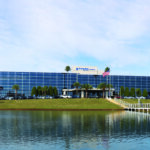Stereotactic Body Radiation Therapy
Cancer patients with smaller, isolated tumors benefit from minimally invasive, highly effective Stereotactic Body Radiation Therapy (SBRT) administered by the Trilogy® System Linear Accelerator with Gated RapidArc®.
Precisely Target Tumors with Stereotactic Body Radiation
For isolated, smaller tumors that haven’t spread to the lymphatic system, potent, targeted treatments of radiation can be precisely applied using our state-of-the-art External Beam Radiation Therapy device, the Trilogy Linear Accelerator.
About Stereotactic Body Radiation Therapy (SBRT)
SBRT uses 3-D imaging and precise radiation beams to target tumors while avoiding hitting healthy areas. This machine can target smaller tumors in a single session or three-to-five sessions for a larger tumor.
Trilogy® System Linear Accelerator with Gated RapidArc®
The Trilogy System is one of the most advanced radiation therapies available. The system is built around an advanced medical linear accelerator, a machine that rotates 360 degrees around the patient to deliver radiotherapy treatments from many angles.

The Trilogy system delivers higher doses of radiation to smaller areas over a shorter period of time and incorporates sophisticated technologies for shaping the radiation beam so that the dose of radiation is limited to the region of abnormality.
By changing the beam shape over time while delivering the radiation, our Radiation Oncologists achieve very fine control over how and where the radiation is administered.
Patient Position Monitoring
To make certain that our patients have not moved during treatment and to monitor the movement of your tumor during treatment, we use an x-ray monitoring system called ExacTrac®. This system includes x-ray machines installed in the floor and ceiling to take fast and accurate position information.
If anything shifts during treatment, the system automatically detects the movements and notifies us. Keeping you and your tumor in position is an added level of safety and security when undergoing radiation treatments.
The Trilogy Gated RapidArc® turns the treatment beam on and off automatically when it detects tumor motions.
Gated RapidArc
The Regional Cancer Center utilizes Gated RapidArc radiotherapy for applicable patients. This technology makes it possible to monitor patient breathing and compensate for tumor motion while quickly delivering dose during a continuous rotation around the patient.
Gating enables the use of RapidArc to target lung tumors with greater precision by “gating” the beam, turning it on and off, in response to tumor motion. Gated RapidArc makes it possible to deliver highly targeted treatments to many types of tumors, including lung tumors that are moving.
Candidates for SBRT
Because the radiation beam is very precisely targeted, this treatment is for patients who have small, isolated tumors (around 5mm or less) that have not yet spread to the lymphatic system.
Types of Tumors
This treatment is used often for early stage cancers. These include:
| Lung Cancer Pancreatic Tumors Bile Duct Tumors Primary and Metastatic Liver Tumors Kidney Tumors | Prostate Cancer Pelvic Tumors Sarcomas Metastatic Tumors (Oligometastases) and more |
Benefits of SBRT
Added Imaging
The Trilogy system has the ability to take CAT scans, so patients can receive their imaging services at the same time as their radiation treatment.
Precise Treatments with Less Visits
Stereotactic radiation therapy delivers a higher dose of radiation than traditional external radiation. As a result, patients can enjoy having to make fewer visits.
Minimal Side Effects
Because of the precise nature of the treatment, structures near your tumor are no longer caught in the field of treatment. Healthy structures and tissues that may have received that radiation are no longer affected. Patients experience less side effects when these healthy tissues are not treated.
Better Outcomes
Conventional radiation therapy’s two-year success rate ranges from 30 to 40 percent, but the success rates for SBRT range from 80 to 90 percent.



